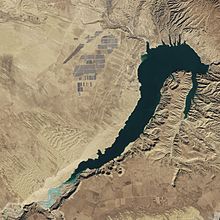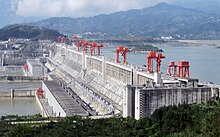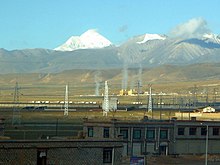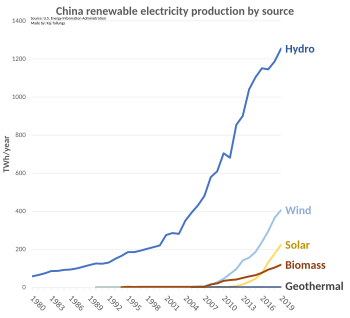Renewable energy in China
China is the world's leader in electricity production from renewable energy sources, with over triple the generation of the second-ranking country, the United States.
The country aims to have 80 per cent of its total energy mix come from non-fossil fuel sources by 2060, and achieve a combined 1,200 GW of solar and wind capacity by 2030.
[1] In 2023, it was reported that China was on track to reach 1,371 gigawatts of wind and solar by 2025, five years ahead of target due to new renewables installations breaking records.
The share of renewables in total power generation is expected to continue increasing to 36% by 2025,[6] in line with China's pledge to achieve carbon neutrality before 2060 and peak emissions before 2030.
[8] Unlike oil, coal and gas, the supplies of which are finite and subject to geopolitical tensions, renewable energy systems can be built and used wherever there is sufficient water, wind, and sun.
[9] However, China is not expected to achieve grid parity – when an alternate source of energy is as cheap or cheaper than power purchased from the grid—until 2022.
[15] According to researcher Dr Cornelia Tremann, "China has since become the world's largest investor, producer and consumer of renewable energy worldwide, manufacturing state-of-the-art solar panels, wind turbines and hydroelectric energy facilities" as well as becoming the world's largest producer of electric cars and buses.
[10]: 33 China encourages foreign companies, especially from the United States, to visit and invest in Chinese wind power generation.
[35] As of 2010, China has become the world's largest maker of wind turbines, surpassing Denmark, Germany, Spain, and the United States.
[39] In 2020, China deployed 71.7 GW of wind energy capacity, a 60% increase compared to 2019 and more than the rest of the world combined.
[53] Work has begun on the ¥250 million Kaiyou Green Energy Biomass (Rice Husks) Power Generating project located in the Suqian City Economic Development Zone in Jiangsu.
The Kaiyou Green Energy Biomass Power project will generate 144 GWh/year (equivalent to 16.5 MW) and use 200 kilotonnes/year of crop waste as inputs.
[59] In January 2010, the State Council decided to set up a National Energy Commission (NEC), headed by then-Premier Wen Jiabao.
[60] China's Sixth Five-Year Plan (1981–1985) was the first to address government policy support for solar PV panel manufacturing.
[10]: 27 Every subsequent plan has done the same and, like the Eleventh, they have also highlighted the importance of low-carbon technology as a strategic emerging industry, particularly in the areas of wind and solar power.
These policies include, but are not limited to Renewable Energy Law,[65] the Safety Regulations of Hydropower Dams,[66] and the National Standard of Solar Water Heaters.
[67] Several provisions in relevant Chinese laws and regulations address the development of methane gas in rural China.
The Great Recession prompted significant stimulus efforts by China to invigorate its then-struggling solar industry.
[10]: 217 These amendments also sought to address interprovincial equity in bearing to costs associated with developing renewable energy.
[72]: 216 President Xi Jinping has said China will reduce its CO2 releases per unit of gross domestic product by 65 percent from 2005 and hit peak CO2 levels by 2030.
Earlier in 2006 Bosch Rexroth started up its Shanghai Jinqiao (Golden Bridge) factory, which is involved in the manufacture, installation, distribution and service of transmission and control parts and systems; the Shanghai facility will also serve as Bosch's principal center for technology, personnel and distribution in China.
Temperate regions will experience changes in boreal forest cover, while vanishing mountain glaciers will cause problems such as water shortages and increased risks of glacial lake flooding.
Coastal zones are under increasing risk from sea level rises as well as pollution and overexploitation of natural resources.
[81] Based on a recently completed survey in 2007, the Standardization Administration of China plans to further develop and improve standards for conservation and comprehensive use of natural resources in the following areas: energy, water, wood and land conservation, development of renewable energy, the comprehensive utilisation of mineral resources, recovery, recycling and reuse of scrap materials and clean production.
[82] The IEA projected that China would contribute nearly 60% of global renewable energy capacity by 2030, with solar power driving 80% of the growth.
[88] In 2018, transportation's share of energy consumption in China was 10.0%, consuming 436.2 million tons carbon equivalent, up by 7.6% in 2009 and 58.6 Mtce in 1995.
Among other things, China should find new points of economic development that move it away from being the "World's Factory" and improves energy efficiency.
[91] Since June 2006 when Chinese Premier Wen Jiabao visited the Shenhua Group's coal liquefaction project and expressed that coal-to-liquids production was one important part of China's energy security, there have been many new 'coal to oil' projects announced by many large coal producing provinces and cities.
Until 2020, Russia exported a total of 30.42 TWh electricity to China, decreasing coal consumption in the latter by 10.17 million tons.
[98] However, there are limited high capacity transmission lines capable of transmitting the necessary amounts of electricity across that distance, leading to curtailments in the northwest and a need for fossil fuels in the southeast.









